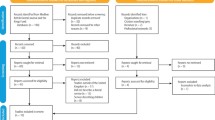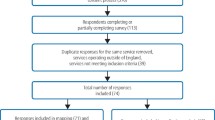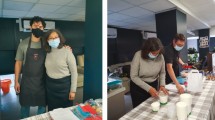Abstract
Introduction As a means of targeting vulnerable populations to offer care outside the traditional clinical setting, mobile clinics exist that permit clinical teams to travel into the community to provide dental care.
Aims To highlight some of the inequalities faced by vulnerable populations, to discuss the benefits of a mobile dental unit (MDU) and how it may address some of these inequalities, and to reflect on some of the achievements of the Bradford MDU.
Vulnerable populations Vulnerable communities may include the homeless population, those affected by substance misuse, those suffering with mental health problems, asylum seekers, or an amalgamation. Such groups are likely to have lower expectations of healthcare and may not seek help until oral disease is advanced, with a large proportion likely to have already lost their teeth.
Bradford MDU The MDU owned by Bradford Community Dental Service is unique in both its longevity of service and populations it serves, and has been providing an outreach dental service to the vulnerable populations of Bradford for the last 16 years. Whilst the COVID-19 pandemic suspended services during the thick of lockdown, the Bradford MDU is slowly re-opening its services, so the care received by these vulnerable populations is no longer compromised.
Key points
-
In the present day, inequalities in healthcare still exist and are predominantly faced by groups with lower socioeconomic status and vulnerable communities.
-
Mobile dental clinics are a means of providing care outside the traditional clinical setting and enable vulnerable groups (such as the homeless population; those affected by substance misuse, mental health issues etc) to access the care they may not seek otherwise.
-
The mobile dental unit provided by the Bradford Community Dental Service is valuable in the diverse populations it reaches out to and the accessible dental care it provides to some of the most vulnerable communities across the city.
Similar content being viewed by others
Introduction
When it comes to a community and the way it is structured, the health and wellbeing of individuals needs to be considered. As communities develop, the needs of individuals along with their health and lifestyles may also change. It is essential for organisations within that community therefore to keep up-to-date with and address these changes, by providing adequate public health measures.1 Public health involves: working together within the community to enable integration; protecting an individual's health and wellbeing; and tackling health inequalities, particularly those that vulnerable individuals and populations may face.2
As a means of targeting vulnerable populations to offer care outside the traditional clinical setting, mobile clinics exist that permit clinical teams to travel into the community to provide various types of healthcare and for the purpose of this article, dental care.
The history of the mobile dental clinic dates as far back as the Second World War, where the delivery of care was vital to the health of the troops in the field. Large numbers of dental officers and dental technicians were recruited in mobile caravans and later, more advanced trucks in North Africa and Europe.3
Over the years, mobile dental surgeries or units (MDUs) have been adopted by various community dental services (CDS), inpatient wards4 and charities,5 as a means of providing dental services for various community groups. The groups that MDUs have enabled dental care to be delivered is to rough sleepers,6 those affected by mental health issues, drug/substance misuse groups and also children with special educational needs as a way to facilitate oral health screening.
The aims of this article are:
-
To highlight some of the inequalities faced by vulnerable populations
-
To discuss the benefits of a MDU and how it may address some of these inequalities
-
To reflect on some the achievements of the Bradford MDU.
Vulnerable populations
The General Dental Council has produced a series of nine standards that dental professionals must adhere to when it comes to patient care.7 'Putting patients' interests first' is at the top of the list and expands to inform the dental team that one must: 'take a holistic and preventive approach to patient care and not discriminate against patients or groups of patients for any reasons, such as nationality, special needs, lifestyle or any other consideration'. This is relevant to all dental patients and may be of significance when it comes to treatment planning for patients with more complex needs and additional vulnerabilities.
The launch of the NHS in 1948 meant that healthcare became primarily free and available to all members of the UK public, regardless of wealth and socioeconomic status. However, to this day, inequalities in healthcare are ever-present, particularly among lower socioeconomic groups. Public Health England's Strategy 2020-25 has identified a number of behavioural risks, including smoking and alcohol consumption and explains how these contribute to overall poor health and potentially early mortality.8 It has been found that lower socioeconomic groups and vulnerable communities have a higher prevalence of such risky behaviours, in addition to increased difficulty accessing healthcare and less opportunity to lead a healthy lifestyle.1 Table 1 has been derived from the King's Fund1 relating to health inequalities and demonstrates some of the wider determinants on general health.
Those likely to be impacted health-wise by the above determinants and fall into the vulnerable communities may include: the homeless population, those affected by substance misuse (drug and alcohol), those suffering with mental health problems, asylum seekers, or an amalgamation of these.1 It is well-documented that homelessness or 'rough sleeping' has increased dramatically over the last ten years9 and is often combined with mental illness and addiction or substance misuse. Research shows it is often those who misuse drugs that tend to have lower expectations of healthcare and may not seek help until oral disease is advanced.9 As a result of their potentially complex and challenging lifestyles, these populations are likely to have multiple health and care needs, including oral health needs that are often not met10 and a large proportion are likely to have lost their teeth since becoming homeless.6 When presenting for dental treatment, these populations are often likely to require emergency care, in addition to careful and holistic treatment planning with a personally tailored preventive regimen.
The MDU
MDUs are a means by which vulnerable populations can obtain dental care and can enable trusts to deliver care where little or no access to NHS dental service exists.11 While some CDSs have provided MDUs temporarily for emergency care or for screening purposes, on a more local level, the MDU owned by Bradford CDS is unique in both its longevity of service and the populations it serves.12 The Bradford MDU has been thriving on the streets of Bradford for the last 16 years after replacing the predated mobile 'caravan' that was historically utilised. The MDU moves from site to site across the Bradford district to deliver dental care for hard-to-reach groups who may otherwise find it difficult to access services. The current programme for the MDU includes six groups, as shown in Figure 1.
Four groups have been consistently treated on the MDU over the years, with the most recent addition of homeless, young, 16-25-year-old adults who are a population supported in and relieved of rough sleeping and guided into employment and training opportunities.13 Run on a rota by a team of four dental officers, senior dental nurses and dental nurses, the sites visited run an appointment book for when the MDU visits, with a 'drop-in' basis at the substance misuse project. MDU staff work closely with interpreting services at the asylum seeker centre, to ensure optimal care is delivered with no barriers in communication. At other sites, such as working women's and substance misuse services, dental staff collaborate with a network of support workers who encourage clients to attend their appointments regularly and provide support in the process.
The MDU contains a dental chair, patient hoist, wheelchair access, x-ray unit and waiting area. The treatment offered to clients is shown in Figure 2.
While more complex restorative treatment, for example, crown and bridgework is not provided, patients have in the past either been referred to a CDS clinic if appropriate, or given information and leaflets on how to find their own general dental practitioner (GDP). All clients who gain access to services must be in receipt of certain benefits so are exempt from dental charges. Although patients are encouraged to find their own GDP after a course of treatment, this is not always possible due to lifestyle barriers and patients are often accepted for recalls and further treatment if indicated.
An example of the activity (number of patients requiring a procedure) provided by the MDU since the opening of the fifth site from December 2019 to March 2020 is documented in Table 2. The number of patients seen is between 5-10 daily at each site once every two weeks.
This highlights some of the treatment provided before the COVID-19 pandemic and national suspension of routine dentistry and demonstrates only a fraction of the care provided over the years. While clinical staff on the MDU make every effort to complete patients' treatment plans in a timely manner, there have been some factors relating to poor attendance and chaotic lifestyles that have meant it has been difficult to complete all necessary treatment. In these cases, the team have worked closely with support workers and site staff to encourage and assist service users in attending where appropriate.
Discussion
It can be concluded that there are a number of benefits in providing a MDU, in particular, to provide outreach services for the more vulnerable populations. The delivery of such clinical services to hard-to-reach and vulnerable groups continues to be a challenge and the oral health needs of each individual is varied and potentially complex. This relates back to the earlier reference to tailor and take a holistic approach towards dental care, while taking into account lifestyle and individual needs of clients accessing these services.7
The service provided by Bradford CDS includes supporting mental health services and is valuable in the diverse populations it reaches out to. MDU staff have worked hard over the years to explore different ways to deliver dental care in an effective and efficient way, in order to maximise the use of this resource. For service users with mental illness, the implementation of the MDU has reduced the need to travel to dental appointments which has led to a patient-centred approach and reduced time away from the wards for staff.14
CDS staff working on the MDU not only experience the satisfaction of helping these groups but are also able to form partnerships with different sites and gain an appreciation of some of the challenges faced by these clients on a daily basis. Some of the sites are also a gateway to other health services and clients can be signposted accordingly.
While MDU services were suspended throughout most of the COVID-19 pandemic, the service is now slowly re-openeing once again but is limited due to the challenges of delivering care during the pandemic. A random sample of clients who accessed the service before the pandemic were contacted to request feedback. Out of 25 clients contacted, only two were contactable and thus two testimonials were provided:
-
'The service offered by the MDU was a good experience. I thought the treatment was "spot on" and the dentist sorted me out'
-
'The treatment I received was overall a good experience and I was made aware of all the treatment options available. I felt everything I needed got sorted'.
A client who attended the MDU via the Working Women's project also provided the following statement:
-
'Having my dental treatment on the MDU made it easier for me and having my teeth cleaned and all the bad teeth removed has given me confidence'.
Conclusion
While feedback provided is disappointingly low, these comments are just examples of how the MDU services are generally well received by clients, which also has a positive impact on the growing number of organisations becoming affiliated with the Bradford CDS. The MDU will continue to thrive on the streets of Bradford with the hope that the targeted vulnerable communities will receive better and more accessible health and social care, to allow them to feel more integrated within society.
References
The Kings Fund. What are health inequalities?2022. Available at https://www.kingsfund.org.uk/publications/what-are-health-inequalities (accessed August 2022).
UK Government. Public Health England. Available at https://www.gov.uk/government/organisations/public-health-england (accessed August 2022).
British Dental Journal. Dentistry in the field - a mobile dental laboratory during World War II. Br Dent J 2007; 202: 105-109.
NHS England. Implementing a mobile dental unit into a mental health inpatient ward. 2019. Available at https://www.england.nhs.uk/atlas_case_study/implementing-a-mobile-dental-unit-into-a-mental-health-inpatient-ward/ (accessed August 2022).
Dentaid. Mobile Dental Unit. 2019. Available at https://www.dentaid.org/dentaid-mdu/# (accessed August 2022).
The Kings Fund. Delivering health and care for those who sleep rough: going above and beyond. 2020. Available at https://www.kingsfund.org.uk/publications/delivering-health-care-people-sleep-rough (accessed August 2022).
General Dental Council. Focus on Standards. 2021. Available at https://standards.gdc-uk.org/ (accessed August 2022).
Public Health England. PHE Strategy 2020-2025. 2019. Available at https://assets.publishing.service.gov.uk/government/uploads/system/uploads/attachment_data/file/831562/PHE_Strategy_2020-25.pdf (accessed August 2022).
The King's Fund. Homelessness, health and housing: joining up services. 2020. Available at https://www.kingsfund.org.uk/blog/2020/03/homelessness-health-and-housing (accessed August 2022).
Graham C H, Meechan J G. Dental management of patients taking methadone. Dent Update 2005; 32: 477-485.
British Dental Journal. Mobile dental units launched to improve access to dentistry. Br Dent J 2010; 208: 99.
Telegraph & Argus. Mobile dental unit to hit the streets. 2004. Available at https://www.thetelegraphandargus.co.uk/news/8004632.mobile-dental-unit-to-hit-the-streets/ (accessed August 2022).
Centrepoint. What We Do. 2021. Available at https://centrepoint.org.uk/what-we-do/ (accessed August 2022).
Community Dental Services. Mobile clinics. Available at https://communitydentalservices.co.uk/services/mobile-clinics/ (accessed August 2022).
Acknowledgements
We would like to thank Julie Stannard, the long-standing senior dental nurse responsible for the running of the MDU, as well as the rest of the dental team that continue to provide an outstanding service for the patients of Bradford.
Author information
Authors and Affiliations
Contributions
Carly Marples and Judith Wright created the idea for the piece. Carly Marples drafted and wrote the manuscript and contacted previous clients to obtain the testimonials used in this manuscript. Judith Wright assisted with editing the manuscript throughout.
Corresponding author
Ethics declarations
The authors declare no conflicts of interest.
Rights and permissions
About this article
Cite this article
Marples, C., Wright, J. Sixteen years on the road: a mobile dental unit for vulnerable communities in Bradford. Br Dent J 233, 503–505 (2022). https://doi.org/10.1038/s41415-022-4981-4
Received:
Accepted:
Published:
Issue Date:
DOI: https://doi.org/10.1038/s41415-022-4981-4
This article is cited by
-
Best practice models for dental care delivery for people experiencing homelessness
British Dental Journal (2023)
-
Mobile dental services
British Dental Journal (2023)
-
Mobile dental units
British Dental Journal (2022)





